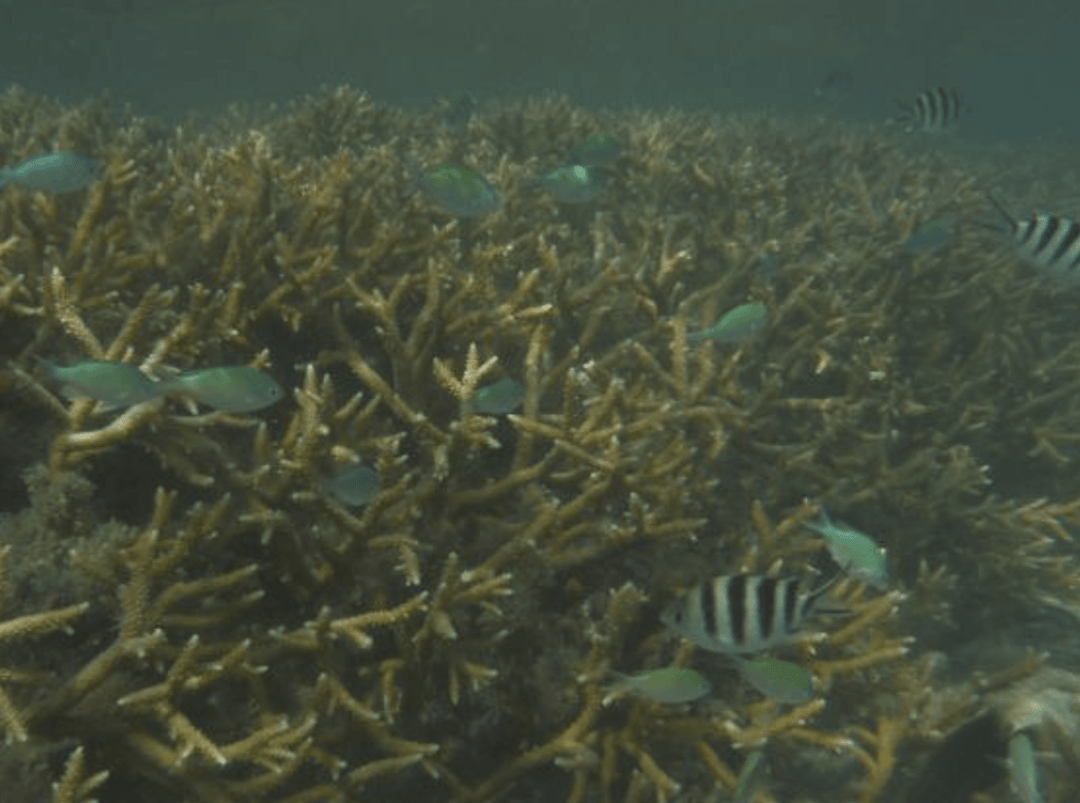Montana State team publishes new research on coral reef health
 A coral reef in French Polynesia where MSU scientists conducted collaborative research examining the importance of sea cucumbers to coral health. Photo courtesy of Zoe Pratte.
A coral reef in French Polynesia where MSU scientists conducted collaborative research examining the importance of sea cucumbers to coral health. Photo courtesy of Zoe Pratte.
BOZEMAN – Montana may not have any coral reefs of its own, but a team of scientists in Montana State University’s Department of Microbiology and Cell Biology is studying a surprising partnership that may offer insight into keeping the world’s reefs healthy.
Associate professor Frank Stewart (Bozeman Magazine's May 2024 Cover Artist) and research assistant professor Zoe Pratte are part of a multi-institutional team that recently published a paper in the prestigious journal Nature Communications examining the importance of sea cucumbers to the health of nearby coral. The paper, titled “Removal of detritivore sea cucumbers from reefs increases coral disease,” was authored alongside researchers from the Georgia Institute of Technology.
Sea cucumbers, Stewart said, are a part of the animal group known as detritivores, meaning they clean the sediments that surround coral reefs, feeding on bacteria, algae and organic matter. Detritivores keep the environment clean and can help reduce the spread of pathogens that threaten coral.
“When you boil things down, it's a pretty straightforward interaction,” Stewart said. “Cucumbers, by cleaning sediment, seem to help corals. The mechanism by which that occurs is not so clear, and that's the next step. That's where more of the microbiome science comes in.”
Coral reefs are known to be in decline and are particularly threatened by disease, note the paper’s authors. Those diseases are commonly spread through the sediment in which corals grow – the very part of the environment kept clean by sea cucumbers. However, sea cucumbers have been harvested by humans for more than 100 years, Stewart said, and population recovery can take decades or can fail altogether. The paper’s authors estimate that at peak harvest, as many as a billion sea cucumbers are harvested annually.
To examine the direct interaction between sea cucumbers and corals, the team used open-water containers surrounding corals at a research station in French Polynesia. The containers allowed the environment to maintain natural water flow, and the team added or removed sea cucumbers to observe the impacts on nearby corals. The results were surprisingly stark.
In one of the coral species studied, removing sea cucumbers for 45 days increased tissue mortality by 370% over mortality levels when the cucumbers were present, said Stewart. The risk of overall coral colony mortality increased by as much as 1,500% in the same time frame.
“Sea cucumbers are so overlooked,” said Pratte. “I think it speaks to the importance of the entire ecosystem staying in balance, not just the things we think are pretty. Ecosystem balance depends on everything, even the creatures on the bottom of the ocean floor.”
With such dramatic results, Stewart said the study points to a potential, if logistically challenging, opportunity for remediation.
“I think the effect points to this idea of keeping the system as close to natural conditions as possible,” he said. “Sea cucumbers were a natural component of reefs for a very long time, and that speaks to an obvious strategy that could help corals. You try to keep the participants there that have that have a positive effect on the reef.”
Stewart said that next steps in this project include narrowing down the chain of microbial events that allows sea cucumbers to be so effective at keeping the environment clean and healthy for coral. But there are also ongoing projects closer to home that illustrate similar phenomena.
This work, said Stewart, highlights sea cucumbers as a touchstone species with outsized impacts on their local environment. When those species are disrupted, the downstream effects can be surprisingly large, and those types of critical species exist in all types of ecosystems, including Montana’s most spectacular landscapes. He highlighted an ongoing collaboration with scientists in MSU’s Department of Ecology exploring the environmental importance of caddisflies, a common sight on many Montana waterways.
“They're everywhere in our stream ecosystems and they're also known to have a disproportionately large effect on other species, including changing the water flow dynamics through the system, impacting things like the retention of nitrogen,” Stewart said. “It's the same idea here, in a very different system. We’re looking at participants with outsized effects and the mechanisms by which those effects exert themselves.”
Whether returning sea cucumbers to depleted environments can help coral reefs recover remains to be seen, but providing more knowledge about the health of delicate and threatened ecosystems can help scientists and managers make decisions about how to protect them, said Pratte.
Stewart said the collaborative project also highlights the interconnectedness of seemingly remote environments. While the species may not be the same around the world, many of the systems and processes are, and the more that is known about those processes, the more diverse species and their homes can be protected.
“This is a principle that’s likely operating in most ecosystems, whether it's an agricultural field or a forest,” he said. “There are likely to be animal and plant components of the system that have these really strong effects. If we can identify those participants and effects on the health of others in the system, we can figure out how it works.”
